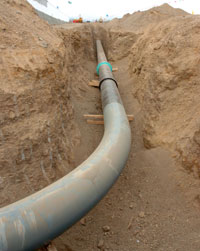
FIRST RUSSIAN-OPERATED PIPELINE ON EUROPEAN UNION TERRITORY REARS ITS HEAD
Publication: Eurasia Daily Monitor Volume: 4 Issue: 43
By:

Given the policy vacuum in Brussels and Washington, the EU member countries Greece and Bulgaria are far advanced in negotiations with Russia on constructing a Russian state-operated oil transit pipeline on their territories, connecting the Black Sea with the Aegean. The Burgas-Alexandropolis project, if carried out, would become the first-ever Russian-controlled pipeline on EU and NATO territory. American interests are also affected, as some major U.S. oil companies are being pressured by Moscow to collaborate with this project.
The project’s Russian coordinator, Deputy Minister of Industry and Energy Andrei Dementiyev, declared on March 1, “With Transneft as operator of this pipeline, we envisage that Burgas-Alexandropolis would become de facto a part of our own pipeline system” (Kommersant cited by Interfax, March 1). He also announced that the Russian companies Transneft, Rosneft, and GazpromNeft, together with a Greek and a Bulgarian firm, have formed a joint company to work out the engineering and economic aspects of the project.
The project is designed to carry Russian and Russian-delivered Caspian oil from the Black Sea to the Mediterranean, bypassing the Turkish Straits. The Russian, Greek, and Bulgarian governments agreed in 2005 to go ahead with this project and decided in September 2006 to sign an intergovernmental agreement by early 2007. Russia will hold a 51% stake in the project.
On January 18, Russia’s monopoly pipeline operator Transneft, along with state-owned Rosneft and GazpromNeft, formed the Pipeline Consortium Burgas-Alexandropolis. On February 7, Dementiyev signed with Greek and Bulgarian government officials a preliminary agreement and completed a draft intergovernmental agreement.
Under these agreements, the Russian consortium includes Transneft with a 33.4% stake and Rosneft and GazpromNeft with 33.3% each. These Russian companies will jointly hold a 51% stake in the pipeline as well as the operating rights for Transneft. The Greek and Bulgarian governments shall hold the remaining 49% initially, with the right to sell portions of their stakes to international or Russian oil companies that would use this transit pipeline. Thus, the majority owner and operator Russia will heavily dominate a collection of minority shareholders. The oil companies will be negotiating, in essence, with the Russian state and its representatives about the terms of using the Burgas-Alexandropolis pipeline.
Moscow seems to feel in the driver’s seat. In his annual news conference, Russian President Vladimir Putin told Bulgaria and Greece to agree expeditiously on the Russian-proposed commercial terms: otherwise, “they will lose this opportunity to become transit countries for Russian and Caspian oil, [as] we shall increase our oil transit volumes through other countries” (Interfax, February 1, 7). Putin apparently alluded to the competing Turkish proposal for a Samsun-Ceyhan pipeline. This would also serve to bypass the Bosporus in transporting Russian and Russian-delivered Caspian oil from the Black Sea to the Mediterranean. However, Russia has chosen the Burgas-Alexandropolis route.
The pipeline would run 285 kilometers from Bulgaria’s Black Sea port of Burgas to the Greek port of Alexandropolis on the Aegean. Its projected throughput capacity is 35 million tons annually in the first stage and 50 million tons in a follow-up stage. Investment for the 35 million ton version is projected at $900 million, which seems either understated or excluding the associated infrastructure-building costs.
The declared rationale for this pipeline is the necessity to bypass the over congested Turkish straits, which could hardly accommodate more oil-tanker traffic, despite growing oil volumes reaching the Black Sea from Russia and the Caspian basin. Safety risks in the Bosporus have risen to near unacceptable levels as a result. Burgas-Alexandropolis can be regarded essentially as an energy- and transport-safety project, useful to that extent. It is in no sense a supply-diversification project, since it would carry oil deliveries reaching Burgas from Russia or via Russia. Contrary to one existing view in the European Union, having multiple routes for Russian-controlled energy supplies is not the same as supply diversification, but rather its opposite.
The pipeline would receive oil at Burgas by tankers from Russia’s ports of Novorossiysk and Tuapse and from the Ukrainian ports of Odessa and Pyvdenny. At present, all that tanker traffic is headed for the Turkish Straits.
The Novorossiysk export terminal handles both Russian and Kazakh oil. Thanks to the CPC pipeline reaching Novorossiysk from Kazakhstan, Russia controls the lion’s share of Kazakhstan’s oil exports and is able to pressure the companies extracting and transporting oil from Kazakhstan, principally ChevronTexaco and ExxonMobil. The Russian government seeks to direct larger volumes of Kazakh oil toward the Russian Black Sea coast, as opposed to the planned trans-Caspian westbound route from Kazakhstan. However, the growing oil volumes reaching the Black Sea require an outlet that bypasses the Bosporus, such as Burgas-Alexandropolis.
The absence of such a bypass option was one of the arguments for creating a trans-Caspian westbound route from Kazakhstan. Now, Moscow will be able to argue that the Burgas-Alexandropolis project justifies long-term arrangements for directing even greater volumes of Kazakh oil to Russia’s Black Sea coast.
The CPC pipeline’s design capacity is 27 million tons annually at present, slated to increase to 65 million tons annually. The Russian government has imposed a halt on that planned increase, pending construction of the Burgas-Alexandropolis pipeline. That halt has set back the production and transportation schedules of U.S. and other companies in Kazakhstan by several years, forcing them to incur considerable losses.
Moscow now wants oil companies in Kazakhstan to bear part of the costs of building the Burgas-Alexandropolis pipeline, as an extra condition to the planned enlargement of the CPC line. Dementiyev named some of those companies: Chevron, BP, KazMunayGaz (Interfax, March 1). If ChevronTexaco and ExxonMobil make that investment and then increase their exports through the CPC pipeline from Kazakhstan to Novorossiysk, they would thereby hurt the prospects for the U.S.-supported trans-Caspian oil export route.
The Odessa-Brody and Constanta-Trieste pipeline projects are also negatively affected. Originally favored by Ukraine, Poland, and the EU in the first case and by Romania and Italy in the second case, those two routes are also options for bypassing the Turkish Straits. However, availability of the Burgas-Alexandropolis outlet will mean long-term use of the Odessa-Brody by Russian companies north-south, instead of the originally intended south-north use of that pipeline for Caspian oil to Europe. Moscow’s superior strategic planning seems to be prevailing over the uncoordinated moves of the other actors.




